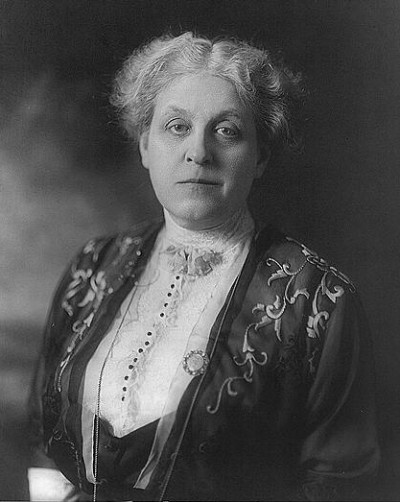Carrie Chapman Catt (Carrie Chapman Catt)

Born Carrie Clinton Lane in Ripon, Wisconsin, Catt spent her childhood in Charles City, Iowa and graduated from Iowa State Agricultural College (now Iowa State University) in Ames, Iowa, graduating in three years. She was a member of Pi Beta Phi, as well as the valedictorian and only woman in her class. She became a teacher and then superintendent of schools in Mason City, Iowa in 1885. She was the first female superintendent of the district.
In 1885 Carrie married newspaper editor Leo Chapman, but he died in California soon after. Eventually she landed on her feet but only after some harrowing experiences in the male working world. In 1890, she married George Catt, a wealthy engineer. Their marriage allowed her to spend a good part of each year on the road campaigning for women’s suffrage, a cause she had become involved with in Iowa during the late 1880s. Catt also joined the Women’s Christian Temperance Union.
Catt became a close colleague of Susan B. Anthony, who selected Catt to succeed her as head of the National American Woman Suffrage Association (NAWSA). She was elected president of NAWSA twice; her first term was from 1900 to 1904 and her second term was from 1915 to 1920. Her second term coincided with the climax of the women’s suffrage movement in the U.S. Under Catt’s leadership the movement focused on success in at least one eastern state, because previous to 1917 only western states had granted female suffrage. Catt thus led a successful campaign in New York state, which finally approved suffrage in 1917. During that same year President Wilson and the Congress entered World War I. Catt made the controversial decision to support the war effort, which shifted the public’s perception in favor of the suffragettes who were now perceived as patriotic. Receiving the support of President Wilson, the suffrage movement culminated in the adoption of the Nineteenth Amendment to the U.S. Constitution on August 26, 1920.
In her efforts to win women’s suffrage state by state, Catt sometimes appealed to the prejudices of the time. In South Dakota, Catt lamented that while women lacked suffrage, “The murderous Sioux is given the right to franchise which he is ready and anxious to sell to the highest bidder.” In 1894, Catt urged that uneducated immigrants be stripped of their right to vote – the United States should “cut off the vote of the slums and give it to woman.” “White supremacy will be strengthened, not weakened, by women’s suffrage,” was her argument when trying to win over Mississippi and South Carolina in 1919.
NAWSA was by far the largest organization working for women’s suffrage in the U.S. From her first endeavors in Iowa in the 1880s to her last in Tennessee in 1920, Catt supervised dozens of campaigns, mobilized numerous volunteers (1 million by the end), and made hundreds of speeches. After the passage of the Nineteenth Amendment to the United States Constitution, Catt retired from NAWSA. Catt founded the League of Women Voters in 1920 as a successor to NAWSA. In the same year, she ran as the Presidential candidate for the ideologically Georgist Commonwealth Land Party. Catt was also a leader of the international women’s suffrage movement. She helped to found the International Woman Suffrage Alliance (IWSA) in 1902, serving as its president from 1904 until 1923. The IWSA remains in existence, now as the International Alliance of Women.
Catt was active in anti-war causes during the 1920s and 1930s. Catt resided at Juniper Ledge in the Westchester County, New York community of Briarcliff Manor from 1919 through 1928 when she settled in nearby New Rochelle, New York. It was during this period that she became recognized as one of the most prominent female leaders of her time.
In 1933 in response to Adolf Hitler’s rise to power in which he used the Jewish race as a scapegoat for Germany’s worst problems, Catt organized the Protest Committee of Non-Jewish Women Against the Persecution of Jews in Germany. This group gathered 9,000 signatures of non-Jewish American women and attached these to a letter of protest sent to Hitler in August 1933. The letter decried acts of violence and restrictive laws against German Jews. Catt pressured the U.S. government to ease immigration laws so that Jews could more easily take refuge in America. For her efforts, Catt became the first woman to receive the American Hebrew Medal. She also wrote the “Do you know” pamphlet, informing people about Woman Suffrage issues. The last event she helped organize was the Woman’s Centennial Conference in New York in 1940, a celebration of the feminist movement in the United States. Carrie Chapman Catt died in New Rochelle in 1947 and was buried at Woodlawn Cemetery, Bronx, NY. Catt Hall at Iowa State University was named in honor of Carrie Chapman Catt in October 1995.
Born
- January, 09, 1859
- USA
- Ripon, Wisconsin
Died
- March, 09, 1947
- USA
- New Rochelle, New York
Cemetery
- Woodlawn Cemetery
- Bronx, New York
- USA



